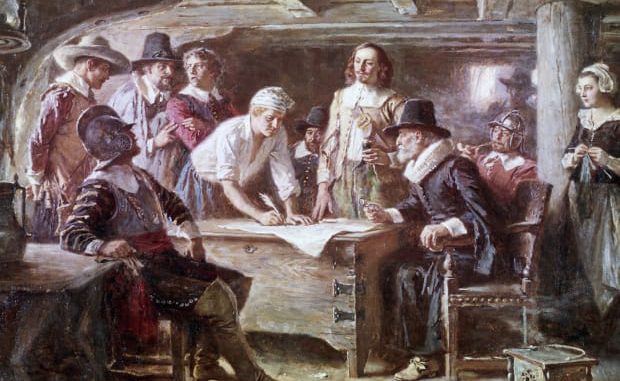
The Mayflower Compact, the first governing document of Plymouth Colony
Following several brutal months at sea, the area now known as Cape Cod was finally seen on the horizon by those aboard the ship, the Mayflower, which embarked on September 16, 1620.
Most, who arrived on Plymouth Rock, were sick from intense sea sickness or other illnesses. Their original destination was intended to be Northern Virginia and the Hudson River, which is New York, today. After months of battling storms, high winds and horrible waves, the 102 people on board didn’t care they had missed their destination by many miles.
“True Pilgrims”
The voyagers included “True Pilgrims” (religious separatists fleeing religious persecution by the Church of England) and those considered to be common folk or merchants, craftsmen, indentured servants (slaves) and orphaned children. Of the fifty men on board, only 41 were considered “True Pilgrims”. The Pilgrims referred to the common folk as “strangers”, despite their months at sea together. The area in which they landed is now known as Provincetown Harbour, Massachusetts.
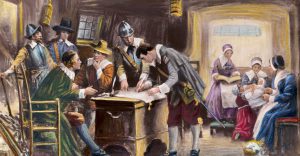
The Pilgrims had received permission from English authorities to settle near the mouth of the Hudson River in Virginia, as it was known at that time. Storms and rocky outcroppings and dangerous shoals deterred them from venturing farther south from where they landed at Plymouth. In short, they attempted to sail to their destination, but conditions caused them to turn back and settle where they originally had landed. Because they landed in an area in which they had no real claim to occupy, the Pilgrims determined their best attempt at a legal standing would be to draw up an agreement.
Mayflower Compact’s Providence
The compact was originally titled, “Agreement Between the Settlers of New Plymouth”. The Mayflower Compact – as it is known today – was signed by those 41 “true” Pilgrims on 11 November, 1620, and became the first governing document of Plymouth Colony. In his history recount, one of the Pilgrims, William Bradford, notes the event as –
“a combination made by them before they came ashore; being the first foundation of their government in this place.”
The document declared that the colonists were loyal to the King of England, that they were Christians who served God, that they would make fair and just laws, and that they would work together for the good of the Colony.
William Bradford Followed John Carver
The men also chose John Carver as Plymouth Colony’s first governor. Carver did not serve long and, upon his tragic death, William Bradford was elected as the governor of Plymouth Colony and is often considered the first governor of the colony, because Carver served such a short time. At that time, only the Pilgrims could vote, while the women and “strangers” were not allowed to vote.
While William Bradford became the most prominent and lasting leader of the newly formed colony, it was John Carver who is considered to have been the one to establish financing for the trip. He also served as governor on board the ship. Carver is often credited with writing the Mayflower Compact, because his is the first signature on the document and follows his style of leadership while on board the ship, but it is most likely that his voice was joined by that of others, including William Bradford.
Impact of the Mayflower Compact in 1620
History shows English colonies at the time always required “patents” or official documents granted by the king or other authorized companies, which gave permission to settle in a particular place. Given the Mayflower passengers had obtained a patent for Virginia, but they landed in New England, their patent was no longer valid. Any sort of authority the group’s leaders could have derived from this patent was therefore also suspect, and some passengers threatened that “when they came ashore they would use their own liberty, for none had power to command them, the patent they had being for Virginia and not for New England” (William Bradford in his history recount). These outbursts from passengers were considered “mutinous”.
The Writings of Bradford
In the book “Mourt’s Relation”, Bradford is noted as stating the need for a unifying, governing document to form “association and agreement” to “combine together in one body”. He continued saying the colonists should agree to “submit to such government and governors as we should by common consent agree to make and choose”. Bradford wrote that, in lieu of their original patent, this new Mayflower Compact “might be as firm as any patent, and in some respects, more sure.”
While local governments were not unusual in England in 1620, a “civic body politic”, as was created by the Mayflower Compact, went much further in the creation of a government that allowed the colonists to govern themselves with authority granted by vote to a governor.
Lost Document
The original Mayflower Compact has been lost, but three slightly different versions exist from the 17th century.
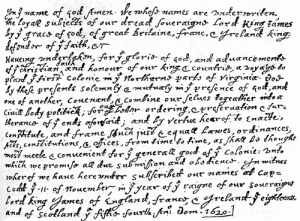
The text was first published in London in 1622 in A Relation or Journal of the Beginning and Proceeding of the English Plantation Settled at Plymouth in New England. A copy of it is found in William Bradford’s handwritten history, Of Plymouth Plantation, made about 1630. And Nathaniel Morton, secretary for Plymouth Colony, published it, along with the earliest known list of the signers, in his history, New England’s Memorial, published in 1669. A list of signers is also found in Thomas Prince’s 1736 book, Chronological History of New England; and Thomas Hutchinson published a list of signers in 1767 as well. It is uncertain if they had access to the original, or were basing their list of signers off Nathaniel Morton’s.
The Legacy of the Mayflower Compact
The legacy of the Mayflower Compact lives on today and its significance has often been debated in the centuries since it was drawn up by the passengers of the ship.
It has often been cited as providing the basis for modern American democracy and, while its influence may have been overstated, there can be no denying its importance in establishing a social contract for the settlers to live by.
Its presence helped ensure order and survival in Plymouth Colony and the basis for self-governance which went on to inspire future generations.
Today, The Mayflower Compact is credited with the concept of Rule of Law as a major tenet of freedom and component present in the Constitution of the United States of America and a base for what has become known as American liberty.
The Original Text of The Mayflower Compact
In the name of God, Amen. We, whose names are underwritten, the loyal subjects of our dread Sovereigne Lord, King James, by the grace of God, of Great Britaine, France and Ireland king, defender of the faith, etc. having undertaken, for the glory of God, and advancement of the Christian faith, and honour of our king and country, a voyage to plant the first colony in the Northerne parts of Virginia, doe by these presents solemnly and mutually in the presence of God and one of another, covenant and combine ourselves together into a civill body politick, for our better ordering and preservation, and furtherance of the ends aforesaid; and by virtue hereof to enacte, constitute, and frame such just and equall laws, ordinances, acts, constitutions and offices, from time to time, as shall be thought most meete and convenient for the generall good of the Colonie unto which we promise all due submission and obedience. In witness whereof we have hereunder subscribed our names at Cape-Codd the 11. of November, in the year of the raigne of our sovereigne lord, King James, of England, France and Ireland, the eighteenth, and of Scotland the fiftie-fourth. Anno Dom. 1620.
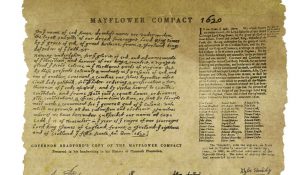
The 41 “True” Pilgrims Who Signed the Mayflower Compact
In the order of their signatures: John Carver, William Bradford, Edward Winslow, William Brewster, Isaac Allerton, Myles Standish, John Alden, Samuel Fuller, Christopher Martin, William Mullins, William White, Richard Warren, John Howland, Stephen Hopkins, Edward Tilley, John Tilley, Francis Cooke, Thomas Rogers, Thomas Tinker, John Rigsdale, Edward Fuller, John Turner, Francis Eaton, James Chilton, John Crackstone, John Billington, Moses Fletcher, John Goodman, Degory Priest, Thomas Williams, Gilbert Winslow, Edward Margesson, Peter Browne, Richard Britteridge, George Soule, Richard Clarke, Richard Gardiner, John Allerton, Thomas English, Edward Doty, Edward Leister.
Sources:
https://pilgrimhall.org/mayflower_compact_text.htm……https://www.ushistory.org/documents/mayflower.htm…..https://www.mayflower400uk.org/education/who-were-the-pilgrims/2019/november/the-mayflower-compact-the-first-governing-document-of-plymouth-colony/……http://mayflowerhistory.com/mayflower-compact……https://www.mayflower400uk.org/education/who-were-the-pilgrims/2019/june/john-carver/history.com/ Feature Image: History.com – Bettman Archive-Getty Images


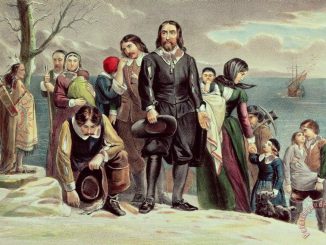
Leave a Reply